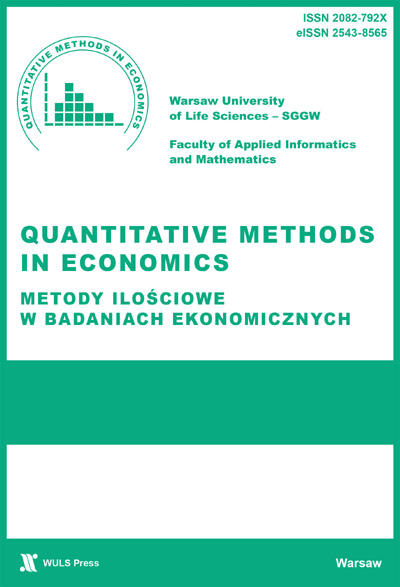Main Article Content
The aim of the paper is to estimate – for twenty-four selected European countries – the influence of the deviations of two factors on the deviation of annual gross national saving per inhabitant. In order to do so, causal analysis has been conducted. The amount of annual gross national disposable income per inhabitant and the average propensity to save have been adopted as the variables affecting the value of saving per capita. Three research hypotheses have been verified in this paper. Data concerning 2021 and 2022 have been used for calculations.
Article Details
Aghion P., Comin D., Howitt P., Tecu I. (2009) When Does Domestic Saving Matter for Economic Growth? IMF Economic Review, 3(64), 381-407. (Crossref)
Alam M.A.Z., Chen Y.C., Mansor N. (2023) Mental Accounting and Savings Behavior: Evidence from Machine Learning Method. Journal of Financial Counseling and Planning, 2(34), 204-218. (Crossref)
Bohdalová M., Pažický M. (2019) Dynamics of Household Savings and Consumption in the Euro Area. Ekonomický časopis, 7(67), 679-697.
Buzatu C. (2015) The Uncertainty Effect on Household Saving Rates in Eastern Europe. The Economic Research Guardian, 5(1), 61-72.
Carlin W., Soskice D. (2006) Macroeconomics: Imperfections, Institutions, and Policies. Oxford: Oxford University Press.
Colander D.C. (2013) Economics. New York: McGraw-Hill.
Costa-Font J., Giuliano P., Ozcan B. (2018) The Cultural Origin of Saving Behavior. PLoS ONE, 13(9), e0202290. (Crossref)
Eurostat database. Available at: http://ec.euroopa.eu/eurostat [access: 12.10.2023].
Feldstein M., Horioka C. (1980) Domestic Saving and International Capital Flows. The Economic Journal, 90, 314-329. (Crossref)
Fenton-O’Creevy M., Furnham A. (2022) Money Attitudes, Financial Capabilities, and Impulsiveness as Predictors of Wealth Accumulation. PLoS ONE, 17(11), e0278047. (Crossref)
Frank R.H., Bernanke B.S. (2013) Principles of Economics. New York: McGraw-Hill/Irwin.
Heckman S.J., Hanna S.D. (2015) Individual and Institutional Factors Related to Low-Income Household Saving Behavior. Journal of Financial Counseling and Planning, 2(26), 187-199. (Crossref)
Kahn R.F. (1984) The Making of Keynes’ General Theory. Cambridge: Cambridge University Press.
Keynes J.M. (1936) The General Theory of Employment, Interest, and Money. London: Palgrave Macmillan.
McConnell C.R., Blue S.L., Flynn S.M., Grant R. (2012) Economics. Principles, Problems, and Policies. New York, McGraw-Hill/Irwin.
Rodrik D. (2000) Saving Transitions. The World Bank Economic Review, 14, 481-507. (Crossref)
Rudzinska-Wojciechowska J. (2017) If you want to save, focus on the forest rather than on trees. The effects of shifts in levels of construal on saving decisions. PLoS ONE, 12(5), e0178283. (Crossref)
Slavin S.L. (2011) Economics. New York: McGraw-Hill/Irwin.
Solow R.M. (1956) A Contribution to the Theory of Economic Growth. Quarterly Journal of Economics, 70, 65-94. (Crossref)
Turczak A. (2017) Characteristics of Saving Generated by the Baltic Countries. Messenger of Armenian State University of Economics, 2, 80-92.
Zhang W.-B. (2012) Habits, Saving Propensity, and Economic Growth. Scientific Bulletin – Economic Sciences, 2(11), 3-15.
Downloads
- Anna Turczak, Patrycja Zwiech, ROZKŁADY WYDATKÓW MIESZKAŃCÓW OBSZARÓW MIEJSKICH I WIEJSKICH W POLSCE , Metody Ilościowe w Badaniach Ekonomicznych: Tom 18 Nr 2 (2017)

Utwór dostępny jest na licencji Creative Commons Uznanie autorstwa – Użycie niekomercyjne 4.0 Międzynarodowe.
Publikowane artykuły dostępne są na warunkach Open Access na zasadach licencji Creative Commons CC BY-NC – do celów niekomercyjnych udostępnione materiały mogą być kopiowane, drukowane i rozpowszechniane. Autorzy ponoszą opłatę za opublikowanie artykułu.





